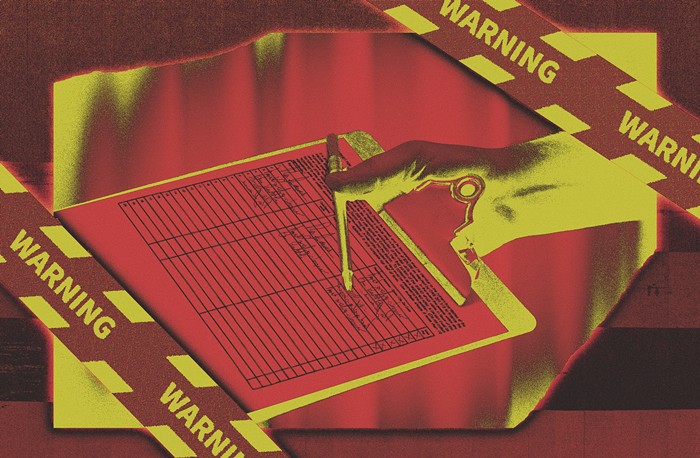UPDATE: Click here for breaking news about swine flu on Slog.
I s it time to panic? As The Stranger went to press, only 67 U.S. cases of swine flu had been confirmed; however, that number was escalating rapidly. Meanwhile, in Mexico, swine flu had sickened an estimated 1,600 people and killed an estimated 152. And on Monday, April 27, the World Health Organization raised its pandemic alert level to 4, signaling "a significant increase in risk of a pandemic."
To deal with staggering budget shortfalls, city, state, and county governments are cutting back on everything, including funding for health care. At the same time, thousands upon thousands of newly unemployed people are finding themselves without health insurance. It's a perfect storm waiting to happen.
On April 27, county health officials briefed the King County Council on the county's preparations for a pandemic. Afterward, council chair Dow Constantine said he was "reassured to know that we have a plan and that the plan's being executed." (The plan involves stockpiling Tamiflu, developing a public education campaign, creating a communications network, and adding hospital beds.) However, he added, "Clearly, even the best public health department is not going to be able to stop a virus from spreading in a world that's as mobile as ours." He added: "The problem here is that a lot of communicable disease and epidemiology funding is subject to getting cut."
Health care isn't just getting cut—it's being decimated. Last year, the county adopted a budget that slashed $11.3 million from public health. Along with another $8.2 million in "lifeboat" funding that was secured only through June, that's more than $20 million in reductions to the county's public-health safety net. Most of those cuts affect things like family planning, child health care, and TB prevention—you know, trivial stuff—but the programs being cut also include public health clinics, communicable-disease testing, and immunizations.
James Apa, spokesman for the King County health department, says the "good news" is that "there was some foresight in funding for emergency response in situations just like this." The bad news? "It takes resources to sustain the level of preparedness we have now." In other words, if the pandemic hits now, we may—may—be ready. If it hits in a couple of years—when, according to the adopted county budget, the risk to public health "as a result of the lack of financing [will be] significant and unacceptable"—those without health care may be on their own.
"The cuts mean that, in the future, we will no longer be able to plan as comprehensively as we did this time," says county council member Julia Patterson, who chairs the King County Board of Health. "This is a perfect example of why we need to adequately fund our public health-care system." This year, the state legislature declined to give the county additional tools to pay for public health.
With Washington's unemployment rate nearing 10 percent, thousands are out of work and without health care. Under the budget adopted by state legislators this week, some 35,000 low-income people will lose their state- funded health insurance, leaving nearly a million state residents with no health care by 2010. The budget also includes less money for nursing homes, fewer state-paid hours for home health-care workers, and fewer workers at hospitals and clinics.
"You have all these people losing their health coverage, and they have to make the tough decision between paying their mortgage and going to the doctor," says Rebecca Kavoussi, assistant vice president of government affairs for the Community Health Network of Washington, which works with more than 130 clinics around the state.
And the "safety net" Washington has in place is beginning to disintegrate. Without health care, free and low-cost clinics will be flooded with new patients who are unable to pay, upsetting an already-delicate balance between paying patients and the uninsured.
The City of Seattle, for its part, has been preparing for a catastrophic event for years. But the city's last big emergency response—to several weeks of snowfall—was an abysmal failure that still has city officials scrambling to cover their asses.
"So far, we're keeping it low-key, because we don't know what kind of risk we're going to have here," says city council president Richard Conlin, who heads up the council's emergency-preparedness committee. According to Conlin, the city has an emergency hospital that can be set up at Seattle Center in about four hours. However, that facility only has space for about 300 beds. That, plus the 500 beds the county has said it can provide, makes 800 additional beds.
King County has between 3,500 and 4,000 hospital beds; on any given day, 90 percent of them are full. If more than a few of the 540,000 county residents officials estimate could be sickened in a pandemic need to go to the hospital, they'll quickly find they don't have anywhere to go. "If we're facing a serious pandemic, we have protocols for how to deal with it, but it's going to be really difficult," Conlin says.
As for what residents can do to deal with the possibility of a pandemic, health officials recommend stocking up on water and nonperishable food (a two-week supply is good), staying home if you're sick, washing hands frequently, and letting public health officials know about suspected outbreaks.
Barb Graff, director of the city's Office of Emergency Management, says she hopes people will stay home if they're sick. But she acknowledges, "There are a lot of people who feel if they stay home, they could lose their jobs. An economic backdrop like we're experiencing makes any cascading thing more difficult." ![]()
This story has been updated since its original publication.



















